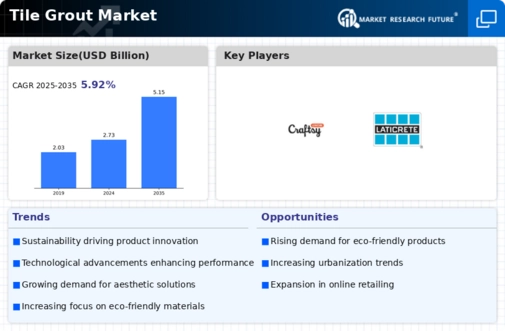Market Trends
Key Emerging Trends in the Tile Grout Market
The Tile Grout market is currently undergoing notable trends, reflecting the shifting landscape in the construction and home improvement sectors. A significant trend shaping this market is the increasing emphasis on aesthetics and design in residential and commercial spaces. As consumers and designers seek to enhance the visual appeal of tiled surfaces, the demand for innovative and aesthetically pleasing tile grout solutions is on the rise. This trend is particularly evident in the use of colored and customizable grouts that complement or contrast with the tiles, providing a unique and personalized touch to interior spaces.
An increase in the demand for decorative tiles and a surge in the number of residential projects are the factors driving the tile grout market growth. The growing number of housing projects around the world is predicted to increase the demand for tile grout in the market. Due to the growing population, most of the developing countries around the world are increasing the demand for employment and affordable homes. The increase in the number of housing projects will increase the demand for tile grout.
Sustainability is another key factor influencing the Tile Grout market. With a growing awareness of environmental concerns, there is a rising demand for eco-friendly and low-VOC (volatile organic compound) grout options. Manufacturers are responding to this trend by developing grout formulations that are not only durable and effective but also environmentally friendly. Green building practices and certifications are driving the adoption of sustainable tile grout solutions, aligning with the broader global focus on environmentally responsible construction materials.
Technological advancements play a significant role in the evolution of the Tile Grout market. Manufacturers are investing in research and development to create grout formulations that offer improved performance characteristics, such as resistance to stains, mold, and discoloration. Additionally, innovations in application methods, such as pre-mixed grout solutions and easy-to-use dispensing systems, are gaining traction, simplifying the installation process for both professionals and DIY enthusiasts.
Global economic conditions and housing market trends also impact the Tile Grout market. Fluctuations in construction activities, real estate development, and home improvement projects influence the demand for tile grout. Economic growth, urbanization, and increasing disposable income contribute to a positive market outlook, as consumers invest in upgrading their living spaces with stylish and durable tile installations.
Regionally, different markets exhibit varying preferences and demands in the Tile Grout sector. For instance, in developed regions like North America and Europe, there is a growing interest in premium and high-performance grout formulations, driven by the demand for sophisticated design solutions. In emerging economies, especially in Asia-Pacific and Latin America, the market is witnessing increased adoption of cost-effective and easy-to-use tile grout products, aligning with the rapid growth in construction and home improvement activities.
The COVID-19 pandemic has also left its impact on the Tile Grout market. Lockdowns, supply chain disruptions, and economic uncertainties led to a temporary slowdown in construction and renovation projects, affecting the demand for tile grout. However, as restrictions ease and construction activities resume, the market is witnessing a rebound, with consumers prioritizing home improvement projects and interior renovations.






Leave a Comment